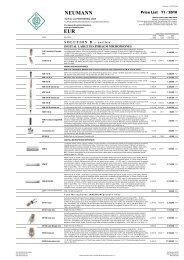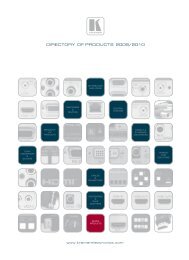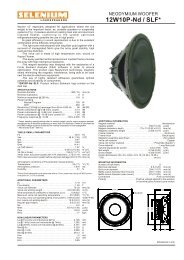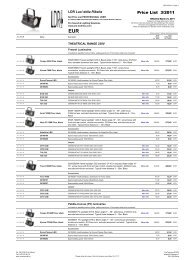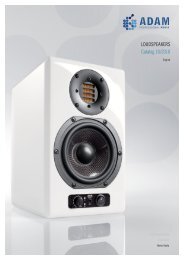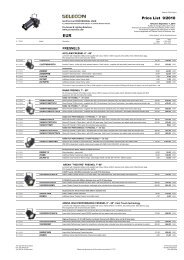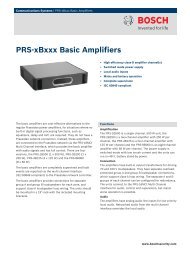Download - Yamaha Downloads
Download - Yamaha Downloads
Download - Yamaha Downloads
You also want an ePaper? Increase the reach of your titles
YUMPU automatically turns print PDFs into web optimized ePapers that Google loves.
Add-on Effects Interview Part 1<br />
Mr. Masaaki<br />
Okabayashi<br />
An Interview with the Creators of <strong>Yamaha</strong>’s Add-on Effects<br />
Part 1: The VCM Compressor, Equalizer, Open Deck,<br />
and Stomp Box Effects<br />
<strong>Yamaha</strong>’s Add-on Effects are marvels of digital signal processing design and engineering. The VCM (Virtual Circuitry<br />
Modeling) effects discussed in part one of this interview deliver the sonic advantages of the finest analog vintage<br />
gear with digital convenience and control, without the noise and reliability issues that plague traditional outboard<br />
sound gear. Although initially made available only as add-on software packages for compatible <strong>Yamaha</strong> digital<br />
mixers, they have become “essential equipment” for a great many professionals in both the audio production and<br />
live sound fields, and are now included in varying combinations in <strong>Yamaha</strong>’s latest VCM-series digital consoles.<br />
We were very fortunate to have an opportunity to sit down with the creators of these remarkable effects packages<br />
and spend a couple of hours discussing how the Add-on Effects came about, and the impact they are having on the<br />
pro audio scene.<br />
Channel Strip<br />
Vintage analog compression and EQ brought to life<br />
in the digital domain through innovative VCM technology.<br />
Includes COMP276, COMP260, and EQ601 effects.<br />
Q: To begin, can you tell us how the Add-on Effects were initially<br />
conceived?<br />
Mr. Okabayashi : One of <strong>Yamaha</strong>’s strengths in producing digital mixers was the<br />
ability to provide built-in effects. Our SPX multi-effect units and reverb units have<br />
earned an excellent reputation over the years, and we’ve been building digital effects<br />
into our digital mixing console since the very beginning, 20 years ago. While giving<br />
our customers the best possible quality in the analog input and output stages, we<br />
also wanted to provide something new that would take maximum advantage of the<br />
digital technology involved.<br />
The idea for the Add-on Effects actually came up when we were beginning<br />
development of the DM series mixers. It was fortunate that in addition to our<br />
hardware product development resources we already had a team devoted to<br />
algorithm development, and at the time they just happened to be looking for a<br />
platform to direct their efforts toward. It was in 2001, I think, that the decision was<br />
officially made to bring these strengths together in an actual product lineup.<br />
Q: What was the market like at the time? What was the<br />
competition?<br />
Mr. Okabayashi : In the professional digital live sound arena <strong>Yamaha</strong> was only<br />
offering the PM1D at the time. We had started with the DM series production<br />
consoles. Of course there were already TDM and VST plug-ins available for the<br />
major computer based audio workstations at the time. But we thought too much of<br />
that genre was aimed at hobby users, and were more interested in creating and<br />
refining technology that worked seamless with hardware designed for professional<br />
use. We decided to be very serious about our signal processing algorithms, and only<br />
develop and deliver the very best available.<br />
Q: So does that mean that when the mixer hardware was initially<br />
developed the software wasn’t yet in the pipeline?<br />
Mr. Okabayashi : Mr. Kunimoto had already been working on physical modeling<br />
technology for musical instruments for a long time, so the foundation already<br />
existed, and we could clearly see the potential for that technology in a professional<br />
audio context.<br />
Master Strip<br />
VCM technology recreates classic tape compression<br />
and saturation with extraordinary realism.<br />
Includes the OPEN DECK effect.<br />
Vintage Stomp<br />
VCM technology merges minute circuit analysis and simulation<br />
of individual circuit component characteristics to deliver<br />
the best in vintage analog sound.<br />
Q: Physical modeling in the VL and VP synthesizers? That was<br />
quite a while ago.<br />
Mr. Kunimoto : Yes. That was around 1993. The VL70m (tone module) is actually<br />
still being made and is quite popular. But in around 2000 we were looking for a new<br />
direction in which to take that technology. We already had reverb simulations and other<br />
effects, and believed that we could create effects that would be ideal for incorporation<br />
into digital mixers. By 2001 we had started doing research all around the country in<br />
order to pinpoint the possibilities and solidify our goals. It all came together in 2002.<br />
Q. That’s really interesting. VL modeling was basically acoustic<br />
musical instrument modeling, but it included technology that<br />
became the seeds of what we have today.<br />
Mr. Kunimoto : That’s right. And by around 2001 or 2002 we had elevated those<br />
seminal effects to a level that would be more than acceptable for use in <strong>Yamaha</strong><br />
digital mixers. If you consider the fact that development of physical modeling<br />
technology was begun in around 1990, the history of the Add-on Effects is actually<br />
quite long. But since our team was originally part of the musical instrument division,<br />
we didn’t have algorithms dedicated to audio processing, such as compressors or<br />
equalizers, at the time we merged with the pro audio division in 2000. That was a<br />
real challenge for us. It’s easy enough to simply produce a compressor or equalizer,<br />
but creating a good sounding compressor or equalizer is a different story altogether.<br />
In fact, we weren’t actually sure what constituted “good sound” in a professional<br />
audio context. What exactly were the sonic characteristics that professional sound<br />
engineers valued?<br />
Q: Was there a specific point at which the direction became clear?<br />
Mr. Kunimoto : Yes. We were very fortunate in being able to recruit the assistance<br />
of several outstanding sound engineers who helped us to achieve the excellent<br />
performance we are able to offer today. We made many, many prototypes that these<br />
talented sound specialists would analyze aurally, easily pinpointing deficiencies that<br />
needed to be addressed as well as positive aspects that could be enhanced. Those<br />
specialists are so familiar with the makings of “good sound” that they were able to<br />
demonstrate the type of performance they wanted by combining existing, traditional<br />
equipment and adjusting various parameters while explaining the merits or demerits<br />
of the end result. This approach made a lot of sense to us, and meant that we were<br />
designing by sound rather than numbers on a spreadsheet or waveforms on test<br />
instruments. The moment we realized just how well this type of cooperation was<br />
working was the moment we became totally confident that we could deliver something<br />
very special. Of course it required many rounds of prototyping and analysis, but we<br />
knew we were headed in the right direction. We supply the algorithms, but the final<br />
sound comes from extensive cooperation with some of the best sound engineers in the<br />
business. When it comes to sound, the most advanced software and hardware is<br />
nothing without a good dose of human sensibility. Of course the study and analysis of<br />
vintage audio equipment is a tremendous aid to understanding what has come to be<br />
appreciated as good sound – sort of a short cut to understanding.<br />
Mr. Okabayashi : Defining “good sound” is very difficult. It can be different<br />
things to different people at different times. For one person it might mean listening<br />
while seated on a luxurious sofa in a comfortably climate-controlled room. It can<br />
depend on a person’s mood, too. The challenge for us is to satisfy what is essentially a<br />
subjective evaluation with the most effective technology we can muster. We believe that<br />
VCM has been very successful in that regard, probably at least in part because of the<br />
enormous amount of feedback from professional sound creators that has gone into it.<br />
Mr. Kunimoto : Yes, and much of that feedback has been very specific. For<br />
example, some people might simply say the sound is “fat” and is therefore good. But<br />
we need to go a step further and understand what constitutes “fat” sound – what<br />
kind of response at what frequencies is that? Our consultants were able to give us the<br />
necessary information.<br />
Q: Very interesting. It sounds like it was more a process of<br />
communication than simply bringing in some vintage gear,<br />
analyzing it with tests instruments, and attempting to reproduce<br />
its characteristics.<br />
Mr. Kunimoto : Of course we needed to do some of that as well, but that type of<br />
laboratory work alone is not going to produce satisfactory results.<br />
We knew from our experience in creating musical instruments that, in contrast to<br />
the end listener, professionals who work with sound on a daily basis and who are<br />
successful in creating sound that is generally accepted as being top-class usually<br />
agree on what constitutes good sound. So when we started seeing agreement from<br />
our consulting engineers we knew we had something of real value.<br />
Q: It can’t have all been easy. Were there any obstacles that<br />
slowed you down?<br />
Mr. Kunimoto : Actually, it all went quite smoothly! Doing the measurements on<br />
the vintage open-reel recorders did take a long time though. We worked around the<br />
clock for several days on that. Even the slightest change in bias, azimuth, speed, or<br />
tape on an analog tape machine completely changes the response. It only takes a few<br />
minutes to measure the deck’s characteristics, but then the moment we make a<br />
change it becomes necessary to bring out the standard tape and go through another<br />
30 minutes of azimuth and level adjustment. So that process repeats: measure for a<br />
few minutes, adjust for 30, then do it all over again. Many times.<br />
The studio pros we worked with on that part of the project were delighted with the<br />
quality of the simulations we were able to achieve. To their trained ears we had<br />
managed to replicate the musicality of the original equipment. So much so that our<br />
model would serve as a “virtual archive” of classic recording equipment that will at<br />
some point become unserviceable. Comments like that were most heartening, and in<br />
many ways a measure of our success.<br />
Mr. Okabayashi : But we should also point out that we were never aiming for<br />
exact simulations. Our goal was simply good sound. One of the most difficult aspects<br />
of that was bridging the gap between what was required by recording and live sound<br />
engineers. That was challenging and enlightening at the same time.<br />
Studio engineers generally have access to a greater variety of equipment, and they<br />
have more time to mix and refine the sound. They are also working in a sonic<br />
environment that has usually been optimized for the job at hand. Live sound<br />
engineers, on the other hand, have to achieve the best possible sound in<br />
less-than-optimum acoustic environments that might change from day to day. And<br />
they have to do it with a minimum of equipment in the shortest time possible. The<br />
working conditions are quite different. So for us it was difficult to strike an<br />
appropriate balance between detailed control and quick operation.<br />
There were some surprises too. Originally we hadn’t even thought that the Open<br />
Deck effects would be used for live applications, but it turned out that live engineers<br />
found it extremely useful as a master compressor for final output.<br />
Mr. Kunimoto : Initially we weren’t even going to make the Open Deck effects<br />
available for live consoles such as the PM1D. But more and more engineers began<br />
using them for live sound, which was quite a revelation for us.<br />
Q: How abut the pedal type effects, such as distortion?<br />
Mr. Okabayashi : The basics for live sound are reverb, delay, compression, and EQ,<br />
but a few engineers like to experiment with wilder effects as well. That’s who the<br />
stomp-box effects are for. At the moment it’s a relative minority, but we believe that as more<br />
engineers realize the creative potential of those effects they will become more widely used.<br />
Mr. Kunimoto : And, frankly, the sound of our flanger, phaser, and other pedal<br />
type effects is way ahead of the competition. Our stomp-box simulations are<br />
extremely musical and can really add something to a mix if used well.<br />
Q: Some people might wonder why, since digital mixers already<br />
have EQ and sometimes dynamics built in, it is necessary to have<br />
additional equalizers and compressors.<br />
Mr. Okabayashi : The functions of the head amplifiers, equalizers, and<br />
compressors that need to be included in every channel, and those that the engineer<br />
wants to insert on specific channels tend to be very different. If the equalizers and<br />
compressors on all channels had a strong, distinct character, that would influence<br />
the overall sound of the console in a big way. The built-in EQ and compression<br />
needs to be more transparent and “practical.” But you still need equalizers and<br />
compressors with a distinctive sound for certain sources: some compressors ideally<br />
match certain types of voices, for example. The Add-on Effects fall into the latter<br />
category. They’re the type of effects engineers will want to use on specific sources.<br />
But I would like to add, once again, that these effects are not exact simulations of<br />
specific vintage devices. They are based on in-depth analysis of vintage gear as well<br />
as current production and live sound mixing needs. They are, in fact, a blend of the<br />
most desirable characteristics of a range of classic equipment, brought together in a<br />
way that best applies to state-of-the-art sound.<br />
Q: Before we move on to discussing Rev-X and ISSP technology,<br />
I’d like to ask Mr. Sendo for his views on the VCM effects from<br />
the perspective of a sound engineer.*<br />
* Mr. Sendoh is a recent addition to the <strong>Yamaha</strong> team. Prior to joining <strong>Yamaha</strong> he was a live sound<br />
engineer with a sound company that is a major player in the field of theater and concert sound.<br />
Mr. Sendoh : Certainly. As mentioned earlier in the discussion, while the standard<br />
dynamics included in <strong>Yamaha</strong> digital mixers are very good at level compensation and<br />
control, many engineers would generally use an external inserted compressor to<br />
achieve a more “driven” sound for picked or chopper style bass, for example. But<br />
now the Add-on Effects 260 compressor does an outstanding job in that situation,<br />
and is in many ways preferable to external hardware. One of the main drawbacks of<br />
external gear is the difficulty of achieving accurate, consistent settings. Noise is<br />
another issue. Since you can easily switch between patches and the bypassed sound<br />
with the Add-on Effects, it’s much easier to decide on the optimum setup for a<br />
particular situation. As Mr. Okabayashi said earlier, the standard built-in<br />
compressors on <strong>Yamaha</strong> digital mixers are ideal for basic level compensation and<br />
adjustment, whereas the Add-on Effects compressors can replace external devices<br />
when you want some extra sonic nuance. The same goes for the equalizers. While<br />
the built-in channel equalizers are the right tool for basic response compensation,<br />
the Add-on Effects equalizers are perfect for enhancing or coloring a sound.<br />
While delivering vintage-style “good sound,” the Add-on Effects offer all the<br />
advantages of digital control and repeatability, which makes them a more practical<br />
and reliable alternative to using actual vintage outboard gear. Also, you can recall<br />
settings that were successful in a previous situation and use them as a starting point<br />
for any other situation, which can significantly improve setup speed and efficiency.<br />
Q: Any comments about using the Open Deck effects in live<br />
situations?<br />
Mr. Sendoh : Open Deck can be a very effective tool for live sound, and I know a<br />
number of engineers who us those effects consistently. They use them to provide a<br />
touch of “saturation” at the output stage for a more driven, exciting sound while<br />
keeping the levels in line.<br />
Q: How about the stomp-box effects?<br />
Mr. Sendoh : Unfortunately they weren’t available when I was mixing live on a<br />
daily basis, but if I had them I would have used them. One of the big advantages of<br />
those effects for live use is the ability to tap-specify the tempo of the phaser and<br />
other effects. That’s something that simply was not possible with actual vintage gear.<br />
45 46<br />
Mr. Toshifumi<br />
Kunimoto<br />
Mr. Satoshi<br />
Sendoh



